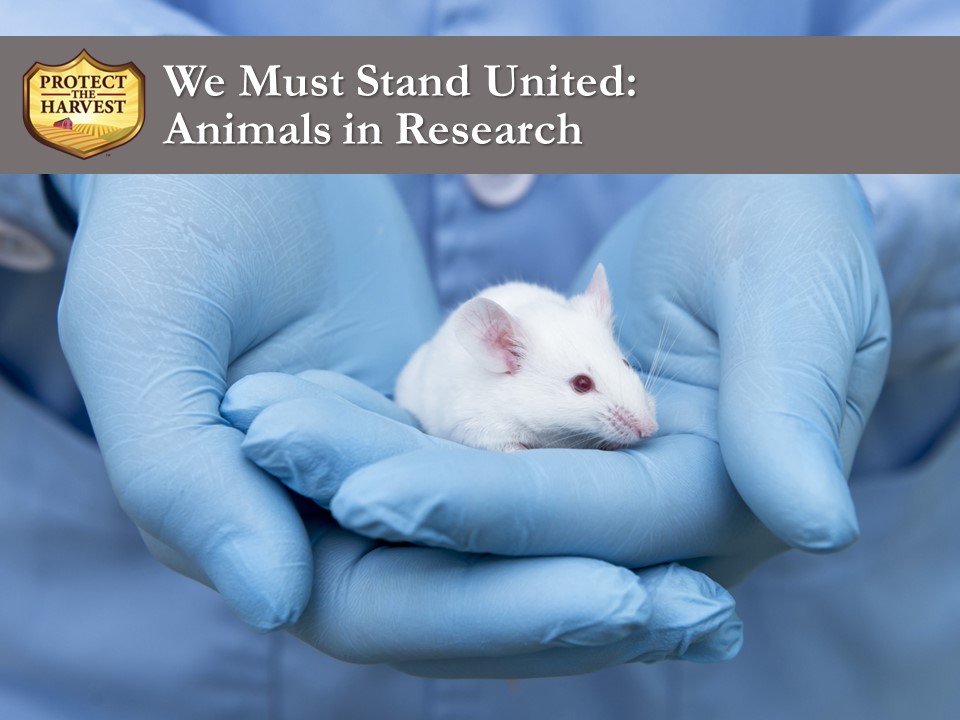Animal Welfare Is an Important Component in Research
It is vitally important to understand that all research animals, whether for biomedical research or educational research, are subjected to the highest regulations. For example, no research study can proceed without a written protocol detailing how many animals are needed, the type, and the reason for using that species.
The study must explain in detail:
• The rationale for involving the animals
• A complete description of the proposed use of the animals
• A description of procedures to be used to assure that pain and discomfort will be limited – to that which is unavoidable
• Which environmental enrichment protocols will be provided
• The type of pain management that will be used
• The type of euthanasia method best suited to minimize pain and stress
The researchers must also show that their study is not a duplicate of another study previously done.
Animal Research’s Vital Role in Scientific and Medical Discovery
Animal research is the study of animals for scientific and medical discovery. Animal research is also used to study safety of medications. Incredible scientific advancements in both human and animal health have been achieved over the past several hundred years with the help of animals. These advancements include things like surgical procedures, vaccines, diagnostic tests, therapeutic protocols and more. One example being the discovery of insulin in dogs. According to the National Institute of Health, “The 1923 Nobel Prize in Medicine was awarded for the discovery of insulin in experimental canines, which continues to serve as an essential model for alternative treatments to preserve the insulin-producing cells of the pancreas and improve the quality of life for humans and dogs with diabetes.”
Our friends at the National Animal Interest Alliance have said it best.
“Research covers a broad spectrum of topics:
• Psychological
• Medical
• Behavioral
• Physiological
• Nutritional
Research provides opportunities for Veterinarians, Physicians, and other medical professionals to:
• Gain necessary experience
• Identify acceptable and unacceptable side effects of pharmaceuticals and procedures
• Facilitate the development of products and processes that enhance human and animal life.”
Food Drug and Cosmetic Act (FD&C)
Animal research is used to study the safety of medications which is mandated by the Food, Drug, and Cosmetic Act (FD&C) of 1938. Before the FD&C was passed, consumers were subjected to publicly marketed drugs not adequately tested to assess human safety. Examples included an early treatment for syphilis that contained mercury and arsenic, eyelash dye that caused blindness, and an elixir marketed for use in children that caused the death of over 100 people. In a broad sense, the FD&C was created to safeguard and protect consumer health and safety from the sale of dangerous products. It is enforced primarily by the Food and Drug Administration (FDA) which requires animal testing of products when a scientifically valid and alternative testing method is not available.
Research Testing Equals Safe Medicines and Vaccines
Animals involved in research can be found working towards medical advancements in a variety of ways. Animals can also be found teaching the next generations of scientists in the classroom. Laboratories and universities all use the “3 R’s”, known as Reduce, Replace and Refine when it comes to animals. It is ethically imperative that animals are only used when there are no non-animal methods available to achieve the scientific goals.
Most medical research is carried out using in-vitro studies, tissue culture, computer simulations and human studies. However, sometimes the nature of the experiment requires a living animal. Using animal models allows for new medical techniques to be studied in a living being (with all organ systems interacting) that a petri dish or computer model cannot provide. Once scientists understand how a disease works, they can begin to develop and test treatments with the help of animals. Dr. Brian Brooks, Chief Pediatric Ophthalmologist from the National Institute of Health, explains that with animal models, “They are able to look for visible changes, microscopic changes, and biochemical changes within the mice that would be impossible to see in living humans. Only after successful trials with animal models are the treatments brought into human clinics.”
Medical Research – Types of Animals
Animals and insects such as fruit flies, worms and mice are popular choices for research subjects due to their speedy rate of growth and their genes’ ability to be manipulated over short generations. The majority of animals used in biomedical research are mice, rats, birds or fish. Mice and rats account for greater than 95% of all animals used. The number of dogs, cats and nonhuman primates combined account for less than 1% of the animals used. With the exception of the increased use of zebrafish, the use of nonrodent animals has been declining over the past three decades due to more refined experimental systems and an intense effort by the biomedical research community to decrease animal use. The number of dogs used in research is currently less than 1/3 of its numbers from those in the late 1970s. The number of nonhuman primates used over the past decade has risen partly due to increasing emphasis of research into human brain function and neurodegenerative diseases such as Alzheimer’s disease.
• Dogs have proved invaluable in developing the heart-lung machine used in open-heart surgery, their use also led to the discovery of the cause of diabetes. Beagles are one of the breeds often used and are considered good models for human diseases including the study of heart disease and testing new medicines.
• Primates such as rhesus macaques are used to study Ebola and Alzheimer’s disease, and in important basic research.
Vaccine Research
A vaccine “trains” the immune system to recognize and fight either viruses or bacteria that cause the illness. To do this, the vaccine must contain molecules from the virus or bacteria to be introduced into the body to trigger an immune response. The molecules are called antigens, and they are present on all viruses and bacteria. Once the antigens are injected into the body, the immune system learns they are hostile invaders, produces antibodies, and remembers them for the future.
There are different types of vaccines designed to fight against different diseases, based on the mechanism of the disease and the least harmful way to introduce it to the body. The 2019-2020 Coronavirus pandemic “COVID-19” caused an experimental type of vaccine to be tried on a group of volunteers in Washington state. This experimental type of vaccine was developed using a genetic platform called messenger RNA or “mRNA”. Instead of injecting actual molecules of the virus, it injects a virus protein which will hopefully trigger a strong immune response. Since it is not the entire virus, this type of vaccine will not make someone ill. Animal trials are an essential step in moving forward with the new vaccine and ensuring its safety in humans once human trials are ready.
Animals Used in Education
Whether it is life sciences in elementary school or dissection in biology in high school, animals are an important tool to learn about living beings. Animals teach us about behavior, genetics, gross anatomy, biology and other life sciences. Animals contribute to our knowledge base every day. Some examples of how animals are used to teach:
• Cats are used to teach neonatal endotracheal tube placement to emergency personnel and to learn to use emergency monitoring devices.
• Medical and veterinary medical students learn about body systems before they see patients.
• Researchers learn about genetics and disease by studying animals, and then applying that knowledge to human medicine.
• Veterinarians and veterinary technician students learn injection techniques and IV catheter placement on animals. Many animals used for educational purposes are adopted out at the end of the course into a loving home (ask any veterinarian about their “vet school dog or cat”).
• Children benefit from animals by learning about behaviors and physical adaptations.
• Classroom animals teach younger children about the animal kingdom, teaching responsibility and care of a living animal and can start a life-long love and appreciation for animals.
Animals in Education and Research vs Computer Models
With the implementation of the “3 R’s” (Reduce, Replace and Refine) and the ethical imperative regarding animals in research, there is a definite shift towards using more computer models. However, the use of a living system is still necessary. A living system is imperative to understand the living, real-time effects of vaccines and drugs and to check for unwanted side effects or flaws. It allows scientists to see how the different living organisms interact with one another when stimulated with drugs or vaccines.
It is important to note that no computer model can completely replace the use of animals in education. Studies of people with learning disorders have shown that the more senses involved in learning, the better the brain can assimilate and remember. When you burn yourself on a hot stove, you learn not to touch it until you know it’s no longer hot. When a medical or veterinary student first learns anatomy, the actual hands-on method of dissecting and identifying the anatomical parts becomes embedded in their brains. Being able to see how an organ functions and why it failed is just as important as memorizing facts.
Animal Extremist Groups Influencing Lawmakers to End Vital Research Projects
Animal extremists have long pushed to end the use of animals in research and have gone to horrific extremes to reach their goals. These extremes have gone as far as firebombing laboratories and harassing and threatening the lives of scientists and their families. These activities have attracted the attention of the FBI and several animal extremist groups and individuals have been placed on the domestic terrorist list. In addition to domestic terror and harassment, these groups have successfully employed the strategy of influencing lawmakers. With the influence of the animal extremist ideology in our government via campaign donations to lawmakers and free public relations opportunities, these same groups are on target to drastically reduce federal funding of animal research. In the final 2020 spending bill, there was language that will require the National Institutes of Health (NIH) to explore alternatives to the use of nonhuman primates. This is problematic as primates are valuable especially for neurodegenerative diseases like Alzheimer’s, as well as Ebola.
Unfortunately, the U.S. Environmental Protection Agency announced in September 2019 that it would be ending its research and funding for all animal testing on mammals by 2035. This is the first federal agency to phase out animal testing. The EPA Administrator, Jon Wheeler, explained that this decision was made in part by the influence of PETA, HSUS, and an anti-animal testing non-profit organization White Coat Waste Project. The EPA will now have to pivot to using nonhuman models in their toxicology studies.
Eliminating Animal Research Has Consequences
Scientists are speaking against the decision by the EPA to end research with animals and have shared concerns that without testing on animal models, potentially dangerous chemicals will be used throughout the country that could have dangerous effects on people and the environment. When testing chemicals and toxins it is important to see how they affect the whole body not just cells in a petri dish.
There are countless other examples of the integral role animals play in the advancement of human and animal medicine. If the world loses the ability to use animal models, we could see the reduction of new medications, procedures, therapeutic protocols and more.
Veterinary Medical Professionals Need to Stand Together
It is important for the veterinary industry to stand together on behalf of animals in research. Those involved in both human and animal medicine must realize the invaluable information that is gathered through animal research. Both human and veterinary patients benefit from animal research through the development of new medications, vaccines, and procedures.
We cannot allow animal extremist groups to control the narrative of research animals. The fact is that the use of animals in research is vital to the maintenance and betterment of all medicine. If animal extremist groups were truly working to improve animal welfare as they claim, they would agree that research with animals is important in doing so.
We urge those working in veterinary medicine to support animal research and advocate for it. The public trust in their veterinarian and team is high. Therefore, it is important for veterinary teams to turn against the false claims made by animal extremist groups about animals in research. Keep in mind that these groups do not care about the health and welfare of animals. Their true goal is to end animal ownership.
Protect The Harvest Supports the Use of Animals in Research
Our organization will always support the use of animals in research because of the important breakthroughs and advancements that would not be able to be achieved without them. Animals in research benefit humans and other animals. As an advocate for animal welfare, not animal extremism, we believe it is in the best interest of all animals for advancements in animal medicine to continue. We know that their involvement is critical to improvements in animal and human health. We will continue to protect their use and work diligently to fight those who are working to end animal research.
We believe that the campaign against animals in research is just another example of the extremists efforts working against improving animal welfare. Instead, these groups want a new reality where animals hold the same civil rights as we do.



